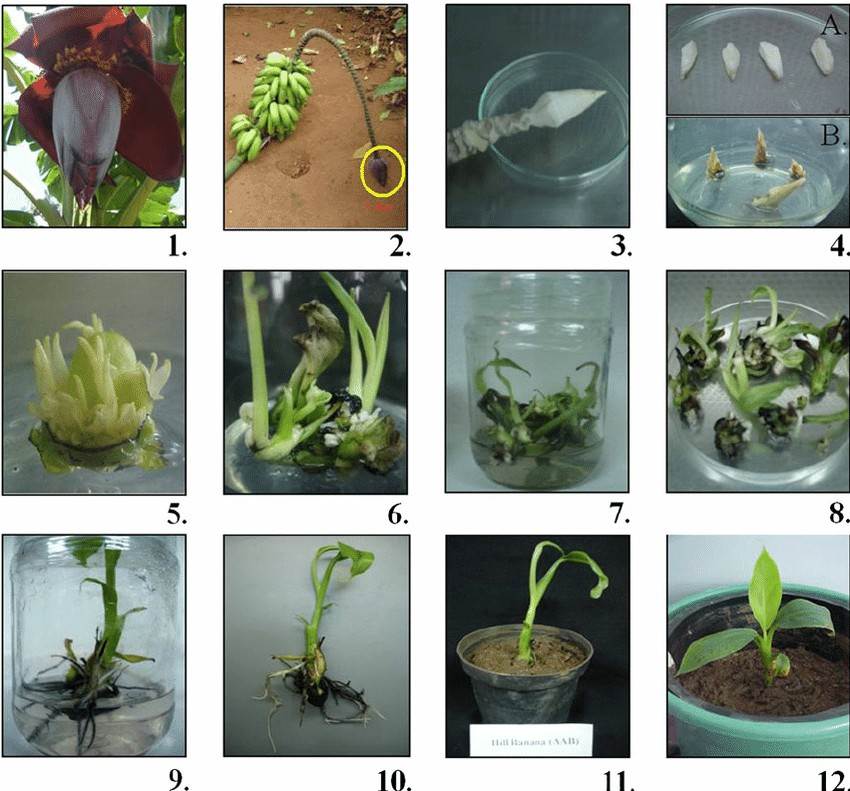The biotechnology applied in banana production is mainly to provide seedlings of superior varieties through tissue culture. At present, almost all banana cultivars with commercial value are triploid, which brings difficulties to reproduction and breeding due to lack of seeds. Banana tissue culture technology plays a key role in banana production, and the application of this technology makes large-scale commercial banana production possible. Because banana tissue culture seedlings have the advantages of fast propagation speed, no virus, high yield and high quality, consistent growth and maturity, stable properties and easy transportation, tissue culture seedlings are currently very suitable for banana production.
Principle
Banana offsets are offspring that germinate and develop from the axillary buds branched from the central column of the corm when the plant grows to a certain size (approximately 16 leaves are grown after planting by offsets, and about 21 leaves are grown after planting by test-tube seedlings), and its vascular bundles are connected with the protocorm. Using advanced bioengineering technology, the growth point of banana offsets is taken as the culture material, and then inserted into the bottle with the culture medium. After a period of cultivation and induction, sterile materials that can be used for proliferation are cultivated, and then transferred to the proliferation medium for subculture. Then the proliferating buds were transferred to the rooting seedling medium for cultivation to generate plantlets with complete root systems.
 Figure 1. Stages involved in the micropropagation from male floral meristems of banana (Musa spp.) cultivar 'Virupakshi' (AAB). (Mahadev, S. R.; et al. 2011)
Figure 1. Stages involved in the micropropagation from male floral meristems of banana (Musa spp.) cultivar 'Virupakshi' (AAB). (Mahadev, S. R.; et al. 2011)
Procedures
Generally, after the bananas start to grow in the warm spring season, go to the banana field on sunny days to select banana stems with high yield and no pests and diseases, and dig out their strong lateral buds as experimental materials.
- Initial Treatment and Sterilization Of Explants
The outer bracts of the offsets were carefully peeled off, rinsed with tap water, and the primordia of the terminal buds and lateral buds were kept, and cut into cylinders about 2 cm long and 2 cm in diameter. Soak the cut suckers in 75% ethanol solution for 30 s on the ultra-clean workbench, and then wash them with sterile water. Then put it into 0.1% HgCl2 or 5% sodium hypochlorite solution for 12-20 min, and rinse it with sterile water 5-7 times.
- Explant Cutting and Inoculation
Put the sterilized offsets on the sterile paper on the ultra-clean workbench, take the central material of the offsets with a sterilized scalpel and tweezers, and cut it into 4 small pieces evenly. Inoculate in the pre-prepared induction medium. The base incision should be inserted into the culture medium. The culture temperature is (30±2) °C. Culture in dark in the early stage, and weak light after the buds are differentiated.
- Subculture
Subculture and multiplication every 30 days. When inoculating, use a scalpel to separate the clustered buds with 2-3 buds as a unit. At the same time, in order to weaken the dominance of the top and promote the growth of the axillary buds on the base plate, cut off most of the pseudostem leaves on the upper part of the main stem. With the increase of the number of subcultures, the amount of 6-BA should be gradually reduced, and Ad will not be used after 3 to 4 subcultures, and a small amount of NAA can be added in the last subculture to facilitate rooting and increase the rooting rate.
- Rooting Culture
When all proliferating buds reach a certain amount, some or all of them must be transferred to rooting culture. When inoculating, cut the buds individually and grade them by size, and insert all the buds (or select large buds) into the rooting medium. In the same bottle of material, those that could not be cultivated to take root were continued to be inserted into the proliferation medium for subculture. After rooting, put the bottle seedlings in a place with better light for cultivation, and turn the bottle body frequently to let the seedlings receive light evenly. After the complete root system has grown, it can be planted out of the bottle.
Note:
- Act quickly throughout material handling to minimize exposure to air and reduce induced failures due to browning.
- As the light increases, the proliferation of buds decreases, but the buds are stronger; on the contrary, the proliferation of buds is more, but the buds are weaker.
- In order to ensure that the species is not affected and reduce the mutation rate, the number of subcultures should be controlled within 10 generations, and the maximum should not exceed 15 generations.
Reference
- Mahadev, S. R., Marimuthu, K. M. An efficient protocol for large-scale plantlet production from male floral meristems of Musa spp. cultivars virupakshi and sirumalai. In Vitro Cellular & Developmental Biology. Plant. 2011, 47(5): 611-617.
Our products/services are For Research Use Only. Not For Clinical Use!
 MEET US AT PLANT BIOLOGY 2024 June 22-26, 2024 Honolulu, Hl #309Learn More
MEET US AT PLANT BIOLOGY 2024 June 22-26, 2024 Honolulu, Hl #309Learn More
 Figure 1. Stages involved in the micropropagation from male floral meristems of banana (Musa spp.) cultivar 'Virupakshi' (AAB). (Mahadev, S. R.; et al. 2011)
Figure 1. Stages involved in the micropropagation from male floral meristems of banana (Musa spp.) cultivar 'Virupakshi' (AAB). (Mahadev, S. R.; et al. 2011)